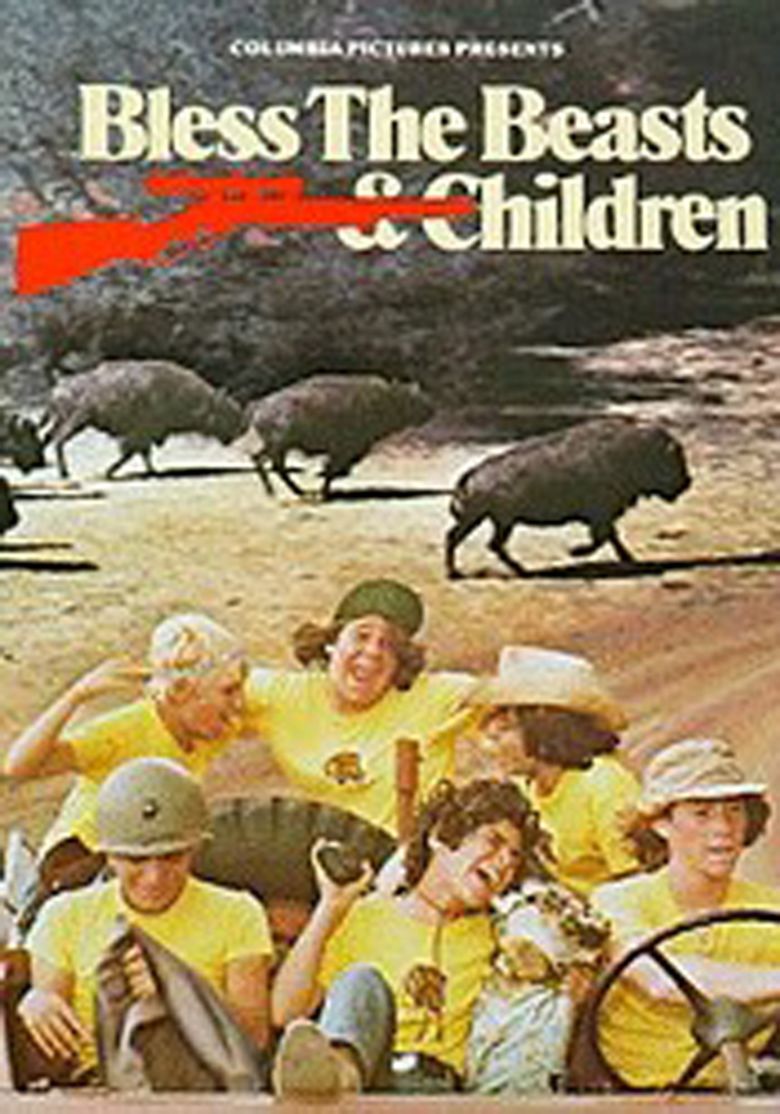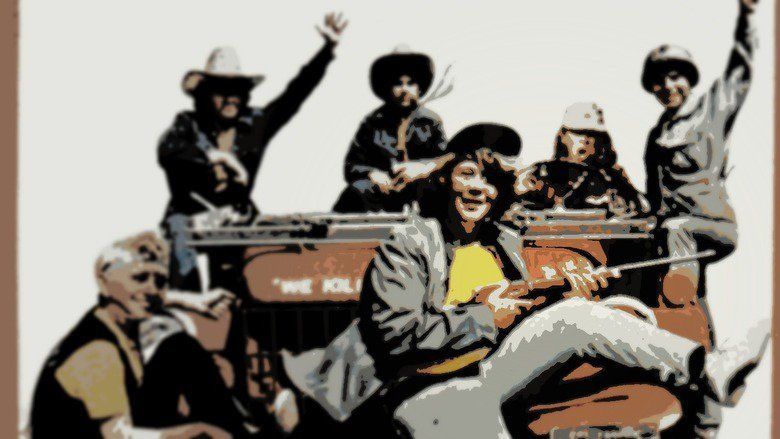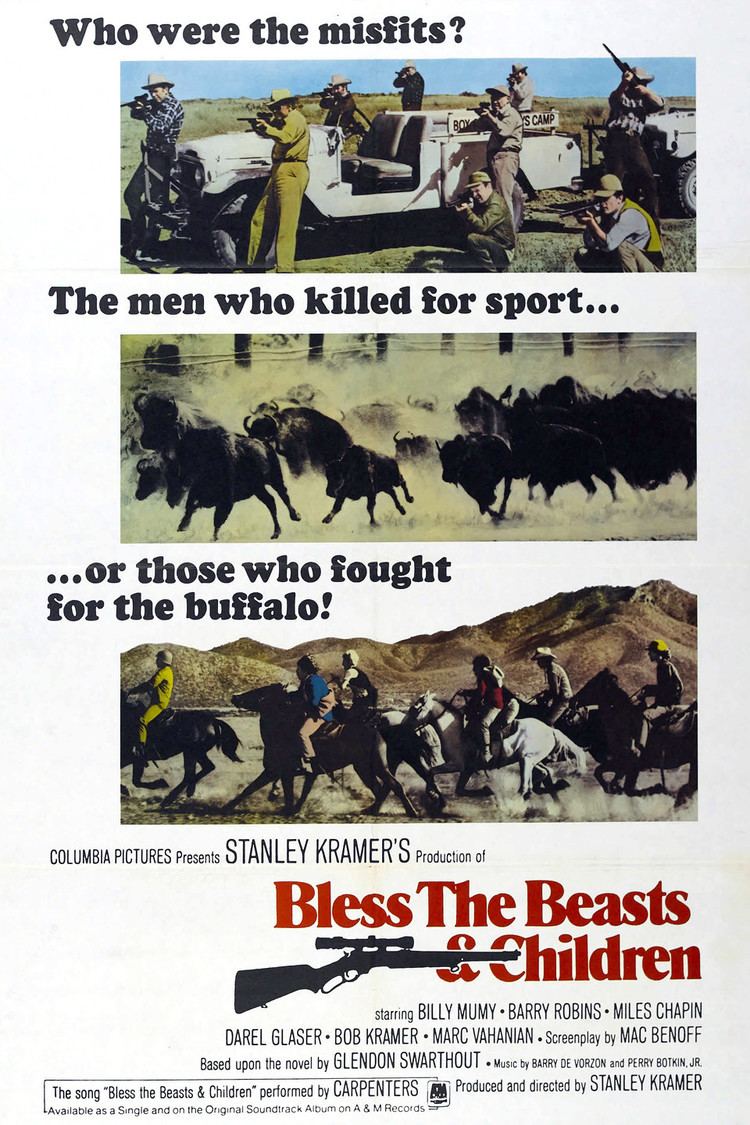Bless the Beasts and Children (film)
6.8 /10 1 Votes
Duration Language English | 6.8/10 IMDb Genre Comedy, Drama | |||||||||||||||||||||||||||||||||
 | ||||||||||||||||||||||||||||||||||
Release date June 1971 (1971-06) (West Germany)August 1971 (1971-08) (U.S.) Featured song Bless the Beasts and Children Cast (Lawrence Teft), (Cotton), (Shecker), Darel Glaser (Goodenow), Bob Kramer (Lally 1)Similar movies The Final Girls , No Strings Attached , Dances with Wolves , Dirty Dancing , Addams Family Values , Jackass 3.5 Tagline Only one animal kills just for the sport of it... Guess which... | ||||||||||||||||||||||||||||||||||
Bless the Beasts and Children is a 1971 film adaptation of the novel of the same name written by Glendon Swarthout. It was directed by Stanley Kramer and starred Bill Mumy (customarily credited then as “Billy” Mumy; this was one of the earliest known times he was credited as Bill Mumy) and Barry Robins.
Contents
- Alan spencer on bless the beasts and children
- Plot
- Cast
- Production and reception
- Soundtrack and score
- References

Alan spencer on bless the beasts and children
Plot

The central characters in Bless the Beasts and Children are six adolescent boys, whose preoccupied parents send them off to the Arizona Box Canyon Boys Camp for the summer. John Cotton (Barry Robins) leads this bunch of “misfits” who are all, to varying degrees, emotionally or psychologically disturbed. Cotton’s group, composed of rejects and outcasts from the other cabins, is known as the “Bedwetters” and the boys are constantly demeaned and ridiculed, which inevitably crushes what little self-esteem they might otherwise have possessed in the first place.
Cotton, through trial and tribulation, becomes the leader of this tight-knit group, and he sets out to mold his followers into a unit that commands respect rather than derision. His is obviously a formidable task in view of the fragile psychological state of the small group, which includes two warring dysfunctional brothers who are known as “Lally 1” and “Lally 2.” Lally 1 reacts to threats against his emotional security by throwing violent temper tantrums, often directed at his younger brother Lally 2, who in the face of these attacks plunges himself into a fantasy world that is filled with tiny creatures he calls "Ooms," and seeks solace in the scorched foam rubber pillow he always carries.
Lawrence Teft III (Billy Mumy) is shown in the film as quiet and sullen, but whenever he is confronted with authority, he turns rebellious. Before he came to camp, one of Teft’s favorite adventures had been stealing cars, but because of the “connections” of his father, Lawrence Teft Jr., he was never arrested for any of his offenses. Hoping that he will learn some self-discipline which will make him worthy of attending Exeter or Dartmouth, his parents enroll him in the camp.
Cotton’s group also includes Sammy Shecker, an overweight, paranoid Jewish boy, whose father is a successful comedian who trades upon the Jewish stereotype. Much to the annoyance of the other boys, Sammy mimics his father’s routines, he compulsively bites his nails, and he is loud, nervous, and obnoxious. The designation “Bedwetters” applies especially well to Gerald Goodenow, the sixth member of the group, who often wets the bed at night--a behavior that had resulted in his having been ejected from two cabins before Cotton takes him in tow. Bedwetting, however, seems to be the least of Gerald’s problems, as he suffers from a phobic reaction to school, which results in several unsuccessful sessions with a psychiatrist. Goodenow is also handicapped by a heavy-handed stepfather who is determined to make a man out of him, by physical force if necessary.
Kramer and his screenwriter Mac Benoff decided to compromise Swarthout’s time sequence by having the entire film set in the present with flashbacks into the past of all the boys, to explicate their presence at the camp. Whereas Swarthout’s novel--thematically powerful though it is--is episodic and difficult for some sixth-graders to follow, the Kramer film flows almost faultlessly to its tragic conclusion. The plight of the American buffalo and any other endangered species is at the center of the film’s focus. Almost predictably, the dysfunctional group, under Cotton’s guidance, set out to free a large herd of the bison, after they witness their perverted macho camp counselor, “Wheaties,” shooting the animals in a festive (and deeply disturbing) western lottery, which is given validation as a proper method to thin out the large numbers by eliminating the “weak” or “sick” buffalo. Of course, the buffalo are not the only targets of this destructive urge, as the Bedwetters--similarly--have been have also been “tamed,” “penned” and crushed in spirit. As a result of their parents’s neglect and/or abuse, they have all been reduced to psychological misfits. Ridiculed and rejected by the other boys in the camp, they are forced to cling even more strongly to their deviant behavior. The boys’s pilgrimage to free the buffalo is also a search for their own freedom.
Cotton perceives that success will free the boys of psychological crutches and allow each to stand alone in defense of self. Cotton sacrifices his life not only for the buffalo but for the boys he has led to this one miraculous triumph. The implication at the end of the film is that the remaining boys are no longer “dings” or “weirdos,” as they have all gained a sense of pride in their abilities and have saved themselves, as well as the buffalo, from extinction. The title of the film (and novel) exemplifies the dual yet unified nature of the theme. Both beasts and children need to be free to roam, to develop and to discover, but the freedom that is given to the buffalo at the film’s conclusion is worthless because their very natures have been altered by man. Outside the fence of the preserve, the tame buffalo will never find wild plains and grasslands on which to roam and their natural habitat, as well as their natural spirit, has been destroyed. The children, however, have regained their spirit and independence and eventually they will triumph over the fear instilled in them by their parents and society. But it is conspicuous that they will require the love and compassion of others.
Cast
Production and reception
A bidding war broke out over the film rights, which Stanley Kramer eventually won. Kramer negotiated with Columbia Pictures for the right to produce and direct the film, which made its world premiere at the Berlin Film Festival in Augustof 1971, as the United States's entry in the international competition. Kramer later commented on Russian reception of the film, stating that they "viewed [the film] as a preachment against Kent State and My Lai," when he had envisioned more of a statement about the "gun cult" in America and how "easy availability of weapons contributes to violence."
Soundtrack and score
The music for the film was composed by Barry De Vorzon and Perry Botkin, Jr.. Their score for the movie included an instrumental selection titled "Cotton's Dream," which was later rescored to become the theme song of the soap opera The Young and the Restless; this was produced by Columbia's television division, now Sony Pictures Television. The soundtrack for the film also includes the movie's theme song, performed by The Carpenters. When gymnast Nadia Comaneci used the original music for "Cotton's Dream" for her routines in the 1976 Summer Olympics, the song gained more popularity and was subsequently released in a reedited and lengthened form as "Nadia's Theme," under which title it became best known. (De Vorzon and Botkin Jr. also wrote lyrics for "Cotton's Dream," but no vocal version of it was known to have charted as of the last days of August of 2017.)
For their work, De Vorzon and Botkin were nominated for the Academy Award for Best Original Song and the Grammy Award for Best Original Score Written for a Motion Picture or a Television Special.
References
Bless the Beasts and Children (film) WikipediaBless the Beasts and Children (film) IMDb Bless the Beasts and Children (film) themoviedb.org
